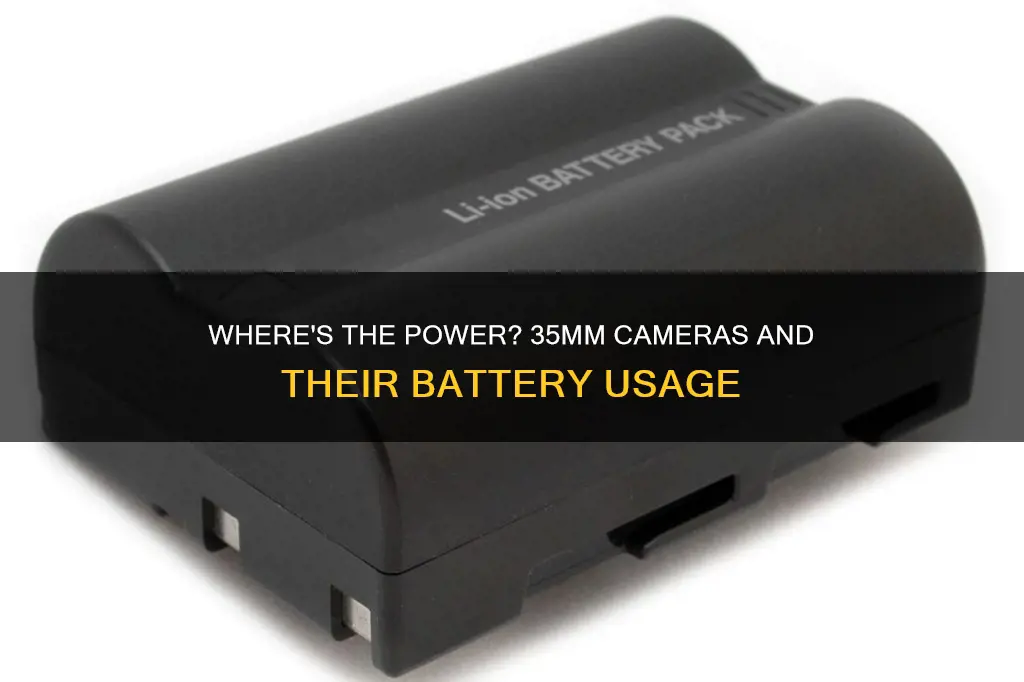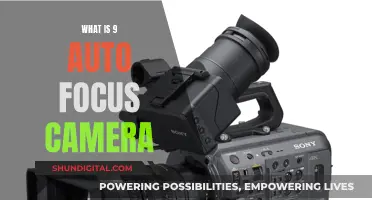
Whether a 35mm camera requires a battery depends on the specific model and its features. Older manual cameras, such as the Nikon FM, FM2, FM3a, and Leica M3, typically do not require a battery, while newer models with electronic features like autofocus, built-in light meters, or motorized film advance may need one. Some 35mm cameras only require batteries for certain functions like light metering or autofocus and can still be used without them.
Film cameras, or analog cameras, do not require batteries for basic operation but may include a built-in light meter that needs a small battery, usually a button cell, to function. On the other hand, digital cameras rely on batteries to power their electronic components.
Finding batteries for older 35mm cameras can be challenging, especially for models that used mercury batteries, which were banned due to environmental concerns. Alternatives such as zinc-air batteries or hearing aid batteries can be used with adapters, but these options may be expensive and require frequent replacement.
| Characteristics | Values |
|---|---|
| Type of camera | Film or digital |
| Film camera battery requirement | No, unless for light meter |
| Light meter battery | Button cell |
| Digital camera battery requirement | Yes |
| Digital camera battery life | Hundreds of photos on a single charge |
| Battery-powered features | Autofocus, light meter, film advance and rewind mechanisms |
| Battery type | AA, AAA, or specialised |
What You'll Learn

Some 35mm cameras require batteries for certain functions
Film cameras, or analog cameras, do not require batteries for basic operation. They are mechanical devices that use 35mm film rolls to capture images. The film is manually advanced using a lever or knob, and the shutter is operated mechanically. However, some film cameras may include additional features that require batteries, such as autofocus capabilities, motorized film advance, built-in flash units, or LCD screens.
Digital cameras, on the other hand, rely on batteries to power their electronic components and capture images. They use a digital sensor to capture images, which are then stored on a memory card. The battery powers the sensor, LCD screen, image processor, and other electronic components.
It is important to note that even if a film camera's battery dies, it can still be used by manually setting the exposure settings. Additionally, there are manual 35mm cameras available that do not require any batteries for basic operation and rely on manual focus, manual exposure settings, and manual film winding.
When it comes to battery requirements for specific 35mm camera models, older manual cameras typically do not require batteries, while newer models with electronic features may need them. Some cameras use common batteries like AA or AAA, while others may require specialized batteries specific to the brand or model.
In terms of battery life, it can vary depending on the camera model and usage. Some modern 35mm film cameras with additional features may only capture a few rolls of film before needing a new battery, while others can last for several months. It is always recommended to have spare batteries on hand, especially when shooting for extended periods or in remote locations.
Charging Your FinePix Camera: A Step-by-Step Guide
You may want to see also

Film cameras don't require batteries for basic operation
Film cameras, also known as traditional or analog cameras, do not require batteries for basic operation. They are mechanical devices that rely on manual operation. The film is advanced using a lever or knob, and the shutter is operated mechanically. However, some features of modern film cameras may require batteries, such as autofocus, built-in flash units, or LCD screens.
One exception to this is the light meter, which is typically powered by a small battery, often a button cell. This battery will need to be replaced periodically. However, even if the battery dies, the camera can still be used by manually setting the exposure settings.
Older film cameras, such as manual SLRs or rangefinders, do not require batteries at all. These cameras rely entirely on mechanical systems to control shutter speed, aperture, and film advance. They are fully functional without any power source, making them reliable and long-lasting.
In summary, film cameras are known for their simplicity and reliability, and many photographers appreciate the hands-on and immersive experience they offer. While some features of modern film cameras may require batteries, basic operation does not, and even light metering can be achieved through external devices or manual settings.
Charging the Eufy 2C: A Quick Guide to Powering Up
You may want to see also

Digital cameras rely on batteries to power their electronic components
Digital cameras have become increasingly popular in recent years, and they rely on batteries to operate. They use a digital sensor to capture images, which are then stored on a memory card. The battery powers the sensor, LCD screen, image processor, and other electronic components.
The battery life of digital cameras can vary depending on the model and usage, but most can capture hundreds of photos on a single charge. It is always recommended to keep spare batteries or a charger handy, especially when shooting for extended periods or in remote locations.
Digital cameras require a robust power source, and most DSLRs and mirrorless cameras use lithium-ion batteries. These rechargeable batteries are smaller than other types and have a larger power capacity. Many camera manufacturers stick with a certain lithium-ion battery design for multiple generations of cameras, allowing users to continue using the same batteries even when upgrading their DSLR.
Other types of batteries used in digital cameras include nickel-metal-hydride and disposable AA and AAA batteries. However, these options are less ideal as they are heavier and may not provide sufficient power for the camera's needs.
In summary, digital cameras depend on batteries to power their electronic components, with lithium-ion batteries being the most common and reliable choice.
Charging Your Bloggie Camera: A Step-by-Step Guide
You may want to see also

Battery-powered features in 35mm cameras
Autofocus
One of the most common battery-powered features found in 35mm cameras is autofocus. Autofocus systems use motors to adjust the lens and achieve sharp focus automatically. These motors are powered by batteries, allowing for quick and accurate focusing, especially in challenging lighting conditions or when capturing moving subjects.
Built-in Light Meters
Another battery-powered feature that has gained popularity is built-in light meters. Light meters measure the amount of light in a scene and help photographers determine the correct exposure settings. Many modern 35mm cameras now come equipped with built-in light meters that rely on batteries to power the metering system.
Motorized Film Advance and Rewind Mechanisms
Additionally, some 35mm cameras offer motorized film advance and rewind mechanisms. These mechanisms allow for automatic film winding and rewinding, making the process more convenient and efficient. The motors responsible for these functions are battery-powered.
It is important to note that not all 35mm cameras have battery-powered features. There are still many manual 35mm cameras available that do not require batteries for basic operation. These cameras rely on manual focus, manual exposure settings, and manual film winding.
Battery Requirements
The need for a battery in a 35mm camera depends on the specific model and its features. Many older 35mm film cameras, such as manual SLRs or rangefinders, do not require a battery to operate. However, newer 35mm cameras often incorporate electronic features that require batteries, such as autofocus, built-in light meters, and motorized film advance.
The battery requirements for specific 35mm camera models can vary. Some cameras use common batteries like AA or AAA, while others may require specialized batteries specific to the camera brand or model. It is important to consult the camera's manual or research the specific model to determine its battery requirements.
Smart Alarm Clock: All-in-One Solution for Your Bedroom?
You may want to see also

The need for a battery depends on the specific model and its features
The need for a battery in a 35mm camera depends on the specific model and its features. Some 35mm cameras require batteries for certain functions, such as light metering, autofocus, motorized film advance, or even automatic exposure modes. On the other hand, many older 35mm film cameras, such as manual SLRs or rangefinders, do not require a battery to operate. These cameras rely on mechanical systems to control shutter speed, aperture, and film advance, making them fully functional without a power source.
For instance, the Konica A-COM 1 camera uses batteries only for its internal light meter, so it can still function normally without a battery, although the user will need to meter using an external device. Similarly, the Petri Racer is a fully manual camera that does not require a battery.
Digital 35mm cameras, on the other hand, rely on batteries to power their electronic components and capture images. These cameras use a digital sensor to capture images, which are then stored on a memory card. The battery powers the sensor, LCD screen, image processor, and other electronic features.
The type of battery required also depends on the camera model. Some cameras use common batteries like AA or AAA, while others may require specialized batteries specific to the camera brand or model.
In conclusion, whether a 35mm camera needs a battery or not is dependent on the specific model and the features it offers. While some modern 35mm cameras have electronic features that require batteries, there are still many older, manual 35mm cameras that do not require any power source at all.
Charging Camera Batteries: Empire Adapter Instructions
You may want to see also
Frequently asked questions
No. Whether a 35mm camera requires a battery depends on the specific model and its features. Older manual cameras typically do not require a battery, while newer models with electronic features may need one.
Some features that may require batteries include autofocus, built-in light meters, motorized film advance, and automatic exposure modes.
The type of battery depends on the specific camera model. Some common batteries used in 35mm cameras include AA, AAA, and specialized batteries specific to the camera brand or model.
Battery life can vary depending on the camera model, usage, and power requirements of the camera's features. It is recommended to have spare batteries on hand, especially when shooting for extended periods or in remote locations.
Yes, some 35mm cameras can be used without batteries, especially older manual cameras that rely on mechanical systems for shutter speed, aperture, and film advance. However, certain features such as autofocus and built-in light meters may not function without a battery.







